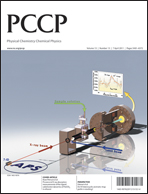Photon induced isomerization in the first excited state of the 7-azaindole–(H2O)3cluster
Abstract
A picosecond pump and probe experiment has been applied to study the excited state dynamics of 7-azaindole–water 1 ∶ 2 and 1 ∶ 3 clusters [7AI(H2O)2,3] in the gas phase. The vibrational-mode selective Excited-State-Triple-


 Please wait while we load your content...
Please wait while we load your content...